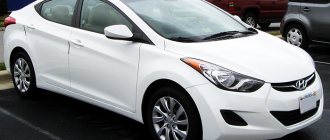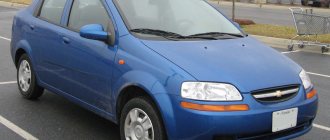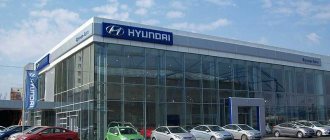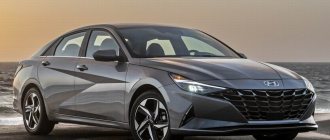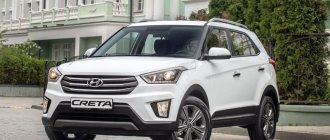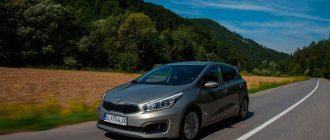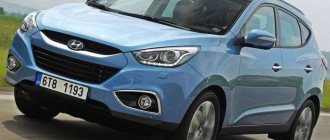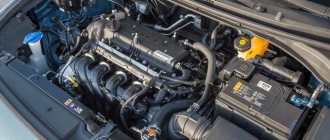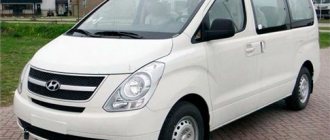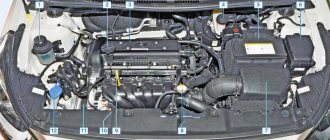Options and prices
The manufacturer has set a very attractive price for the 2021 Hyundai Tussan.
So, the starting version will cost from 990 thousand rubles. This price will include an emergency braking system, several cameras, heated and electrically adjustable seats, as well as many other interesting features. For the “coolest” configuration, the characteristics of which promise to be much more interesting, 1.61 million is requested. For this money, the buyer can count on a panoramic roof, many sensors, cruise control with the option of lane keeping control, heating for each seat, anti-theft, higher quality music and a multimedia system, as well as additional driving assistants and safety elements.
New products
Where Hyundai cars are made for Russia and other countries
The Russian plant is constantly striving to develop, so this company recently offered about five options for different car models. Hyundai Solaris has become the fourth generation of Accent, popular among Russian car enthusiasts. The name of the third generation, known to Russians as “Verna”, was remembered and went down in history as an unsuccessful project. Nowadays such a car is almost impossible to find. The reason for the failure is errors in the miscalculation of marketers. The car turned out to be too expensive. Therefore, production of “Verna” has been discontinued in Russia.
Chinese Solaris manufacturers began calling their cars Hyundai Verna. They have this vehicle equipped with red interior lighting, slightly modified interior elements and a colored front bumper and headlights.
HMMR is one of the largest automobile manufacturers in Russia, producing 200,000 vehicles per year. The plant is equipped with modern industrial automation equipment, including 185 robots, and has created about 7,000 jobs in the region. The St. Petersburg plant achieved 46% localization with the cooperation of local suppliers.
A question of expediency
Why is that? Factory workers explain this by economics. It is advisable to engage in stamping when producing over 150 thousand cars per year. Meanwhile, Hyundai Trans Kazakhstan’s immediate production plans imply the production of 30 thousand cars per year (in 2021), at the next stage – 45 thousand cars, and in the future – 60 thousand cars per year.
And that's reasonable. At the end of 2021, 17,857 Hyundai cars were sold in Kazakhstan. Even taking into account the growth in sales, as well as the fact that about half of the plant’s products will be export-oriented (to the CIS countries, but for now this is only Uzbekistan and Belarus), the plans look realistic, to produce more - perhaps only for storage.
Comparison with competitors
Where are Renault Logan produced for Russia and other countries?
The 2021 Hyundai Tucson is far superior to its counterparts, the Toyota RAV-4 and Honda CRV, because it offers a better driving experience and is well insulated. The interior of this car is much better than its two competitors. Hyundai engineers understand that many people spend a lot of time in their cars, so they've done a good job of making the seats comfortable, providing access to interior storage, and making the infotainment system easy to access.
The Tucson also has a better MSRP, making it much cheaper than the competition
If you look for Hyundai incentives like cash rebates and 0% APR, you can take advantage of huge savings that aren't available when you purchase a RAV-4 or CRV. Hyundai manufacturers are making it much easier for people to buy a quality car with the space, features and versatility they need.
Comparison of technical characteristics
Where are Renault cars made for Russia and other countries?
A comparison of the Hyundai Tussan N Line or Hyundai Tussan will allow you to answer all these questions, which can start with the dimensions of these crossovers. Their length/width/height are completely identical and equal to 4480/1850/1655 mm. There are also no differences in ground clearance. It is 182 mm, which indicates good cross-country ability of the vehicles.
The equipment of the cars is almost the same. Even in minimal configurations, they are equipped with many advanced safety systems and comfort options, as well as electronic assistants. In both cases, such equipment is quite reliable and proven. Therefore, there is no need to doubt the durability of the new product and the correct operation of its systems.
Results
Thus, the production of Hyundai cars is established in several dozen countries.
If we talk about Russia and Hyundai production for this country, the following points stand out:
- South Korea, Ulsan. The largest plant where 70 percent of all Hyundai cars produced for export are produced.
- The Taganrog plant (TAGAZ) assembled some Hyundai models until 2010.
- In 2008, construction began on its own automobile plant in St. Petersburg, which began producing cars in 2010. The plant still operates today. It is located in the Kamenka district.
- Türkiye. It is also home to a large Hyundai manufacturing plant. It has been working since 1998 to this day.
In addition to the countries listed above, Hyundai is assembled in China, the USA, the Czech Republic, Brazil and others. But cars from these countries are arriving in Russia less and less often or not at all.
As many have already noticed, in the last decade there has been a fashion for crossovers. Each company considers it its duty to present fans with at least one model of this class. It is worth noting that if you believe the statistics, crossovers are indeed one of the best-selling cars on the modern market. Photo: Hyundai Tucson 2017
As for the South Korean company Hyundai, at the moment its most successful crossover is considered to be the Hyundai Tussan. He took over this title from his predecessor, the Hyundai ix35, which was presented to the public back in 2008.
I would like to say right away that those car enthusiasts who, when purchasing a Hyundai Tucson, plan to acquire a large SUV, will be disappointed. After all, even with the naked eye it is noticeable that this crossover is just a slightly larger passenger car. As confirmation of this, the ground clearance of the Tussan is only 18 cm, which is a distinctive feature of any average “passenger car”.
Car enthusiasts note the quality of the Hyundai Tussan. This figure is very high, regardless of the place of production of the crossover.
Hyundai Tussan is assembled in factories in the following countries:
- South Korea is the most powerful and productive plant, producing cars for the local market and for the Asian market;
- Turkey is the second largest capacity that makes crossovers for the local market, for the African region and the markets of the Middle East;
- The Czech Republic is a small South Korean branch, the only one in Europe that produces the Hyundai Tussan. The plant assembles cars for the European market, CIS countries, and Russia in particular (there is unverified information that Czech Tussans are also exported to the USA).
In addition, the South Korean company has branches in India, Mexico and the USA, but Hyundai Tussan is not yet assembled there. Although at the moment there are no plans to transfer production to these plants, company representatives do not deny the possibility of such a course of events.
Despite the fact that there is a lot of information on the Internet that Tussan is produced in domestic factories, this is not true. For Russia, as mentioned above, crossovers are supplied from the Czech Republic.
It is worth noting once again that the build quality of the Hyundai Tussan does not depend on the country of manufacture, since each plant has Korean specialists who carefully monitor the production process.
Video: Hyundai plant in the Czech Republic
Operational problems
As one of the main problems, owners of the first generation crossover note the low quality of the metal and the lack of galvanization of the body. As a result, the car may not only show yellow spots, but also actual pockets of corrosion. Therefore, even if luck smiles and you manage to find a model in good condition on the secondary market, the first thing that will need to be done is to have the body processed. Rust most often appears on the rear arches and cornices. Often, the rubber seals on the doors fail, resulting in drafts and the interior being filled with extraneous sounds.
Engine
Due to design features, the timing belt of a 2-liter gasoline engine has a belt drive from the crankshaft, an exhaust camshaft and a chain between the intake and exhaust camshafts. The chain has an almost unlimited resource, but the belt must be replaced every 50 - 60 thousand kilometers. At least once every 90 thousand km it is necessary to adjust the valves, since this engine does not have hydraulic compensators.
The 2.7-liter engine, like the 2-liter engine, has a combined timing drive, but it already has hydraulic compensators installed, which should be replaced every 150 thousand km.
The main advantage of the diesel engine is its efficiency. Otherwise, the maintenance and maintenance of such a power unit is much more expensive. With a mileage of 120 thousand km. Problems begin with the injectors, injection pump and EGR valve.
After 7 years of operation, the cooling system begins to cause problems. This may be due to either leaking pipes or failure of the radiator itself.
Transmission
The automatic transmission has a high level of reliability. Provided you change the oil and filter every 60 thousand kilometers, the transmission will last up to 200 thousand km without any problems. without major repairs. All other problems associated with delayed gear engagement or loss of power are the consequences of driving on dirty or low-quality oil. The fluid in the bevel gearbox and coupling should be replaced at least once every 60 thousand km. At the same time, the coupling, if it is not constantly subjected to extreme loads, will last 150 - 200 thousand kilometers.
Mechanics, there are mechanics. And even with careful operation, after 120 - 150 thousand mileage, clutch repair is necessary. The service life of the release bearing largely depends on the type of driving and operating conditions of the vehicle.
Chassis and steering
The crossover suspension is the most problematic part of the car. The first to fail, already at 30-40 thousand, are the struts and bushings of the stabilizers. Ball joints and tie rod ends are the next items to go. This usually happens at 50-60 thousand km. Only with very careful driving their service life can be 80 - 100 thousand. The rear silent blocks on the front arms will have to be changed closer to 80 thousand. At the same time, the front ones have an almost unlimited service life. More than 100 thousand silent blocks of the rear levers are produced. The pads must be replaced every 30 - 40 thousand km. Brake discs last much longer and can easily cover 100 – 120 thousand kilometers.
Closer to 80 thousand kilometers, the steering rack oil seals begin to leak, but here, due to its maintainability, you can get by with minimal costs.
Quality is sacred
But the other side of the coin is the level of automation. It is advisable to install industrial robots for much larger production volumes, according to factory workers’ calculations – from 70 thousand cars per year. Therefore, welding is semi-automatic, painting is done manually (there is even a “training” body on which beginners are taught to practice movements when applying material).
This, of course, immediately raises the question of how well we can maintain quality parameters. Naturally, the factory workers convince us that everything here is strictly according to the standards of the Motor Hyundai Company. And here is a visual demonstration. Behind the glass is a control and measuring machine that measures the geometry of the body using 800 control points and also checks how it is welded. The whole process takes 8 hours, based on its results an overall assessment is given.
“The standard is 100 percent, 95 percent is acceptable. If less, then the body and the batch from which it was taken must be disposed of. Our figure is about 96 percent. We checked St. Petersburg cars, so we can say that our bodies are welded no worse,” says Maxim Tarasov. “We look at the points where the standard did not meet, we find out what is the cause of the problem, is it our welding or is it a matter of stamped parts. If the reason is the second, we send a report to St. Petersburg. That is, we work on quality together with the Russian plant.”
Control is also present at other stages of production: after welding for minor defects, in the inspection area after cataphoresis, and then in the inspection area after applying paintwork and drying. After assembly, the cars are sent to the wheel alignment stand, brake test stand, and then undergo road tests on the factory test track. Then Final Inspection - where each car is completely inspected, compliance with the equipment is checked, etc. After which the equipment is sent to the finished product warehouse.
Several sites around the plant can accommodate about a thousand cars. But Hyundai Trans Kazakhstan does not work at the warehouse - all the cars have already been ordered. Accordingly, those models ordered by dealers are produced in the appropriate versions.
The production of cars for Belarus has already begun. As Maxim Tarasov reported, there are about 200 cars on order so far - Santa Fe and Sonata. About 500 more are planned before the end of the year, and these will already include the new Elantra and Tucson. However, the figures are by no means final; everything will depend on the needs of Belarusian dealers.
This article was taken from the site https://www.abw.by/
Salon
The interior decoration of the new Tussan is truly a true work of art. Even in comparison with its predecessor, whose interior, by the way, was considered one of the best in the segment, the interior of the updated “Korean” looks grandiose. Everything is great here - from the successful layout to the phenomenal ergonomics.
First of all, I would like to note the dashboard, which, although made in a classic style, has a very progressive and high-tech look. In its very center there is a proprietary touch display, synchronized with the on-board computer and navigator, and on both sides there are stylish deflectors. One level below is the climate control system control unit, which is in the most optimal position. By the way, the console is rotated relative to the driver at an angle that makes the control process as easy as possible.
As for the steering wheel, the developers installed a traditional three-spoke multifunctional element, which is freely adjustable in two directions. The well below houses an analog speedometer and tachometer, as well as a color mini-display of the on-board computer.
The front seats look quite ergonomic and roomy. As has already become known, even in the basic configuration the chairs will be equipped with heating and electric controls. In the rear, of course, you shouldn't expect anything like that, but given past experience, it's safe to say that three adult passengers will fit easily.
The quality of the finishing materials should not cause any complaints; moreover, everything is chosen harmoniously and tastefully. The only drawback of the Tussan 2021 interior is the insufficiently developed lateral support, but this is not that significant.
CKD and SKD
The tour begins from the assembly shop, where we see Elantra and Sonata sedans, Creta, Tucson, Santa Fe and Palisade crossovers.
All of them are produced using the SKD method. What does this mean? “The car body is almost assembled, we are installing the engine, gearbox, front and rear suspension, exhaust system, engine control unit, wiring, battery,” director of the enterprise Maxim Tarasov lists the operations. He accompanies us around the workshops and talks about the main technological operations.
With large-unit assembly, their number is relatively small, about 150 in total. There's not much to see here, so the bulk of the tour is spent on the CKD line where the Accent is manufactured - there are about a thousand operations there in assembly alone. Plus, welding, cataphoresis and painting.
Here, the process of producing one car takes almost a day; the only thing that prevents us from calling it full-cycle production is the lack of a stamping shop - finished body parts are supplied from the plant in St. Petersburg. And parts for the Tucson will come from Ulsan, South Korea.
Maintenance costs
Despite the fact that some motorists and experts consider Tucson maintenance to be expensive, it will cost much less than maintaining a German crossover. Cars are quite reliable with timely and high-quality maintenance. But if necessary, repairs can be expensive. This especially applies to Opel.
Tucson options and prices
| Equipment | Engine | Volume, l | Power, hp | checkpoint | Drive unit | Acceleration to 100 km/h, c. | Max. speed, km/h | Consumption per 100 km, l | Price, rub. |
| 1.6 T-GDI DCT 4WD Dynamic | petrol | 1.59 | 177 | robot. | full | 9.1 | 201 | 9.7 / 6.6 / 7.1 | 2 023 000 |
| 1.6 T-GDI DCT 4WD High-Tech plus | petrol | 1.59 | 177 | robot. | full | 9.1 | 201 | 9.7 / 6.6 / 7.1 | 2 198 000 |
| 2.0 AT 2WD Primary | petrol | 2 | 150 | machine | front | 11.1 | 181 | 11 / 6.2 / 7.1 | 1 568 000 |
| 2.0 AT 4WD Dynamic | petrol | 2 | 150 | machine | full | 11.8 | 180 | 11.9 / 6.3 / 8.1 | 1 953 000 |
| 2.0 AT 4WD Family | petrol | 2 | 150 | machine | full | 11.8 | 180 | 11.3 / 6.8 / 8.1 | 1 748 000 |
| 2.0 AT 4WD High-Tech | petrol | 2 | 150 | machine | full | 11.8 | 180 | 11.9 / 6.3 / 8.1 | 2 088 000 |
| 2.0 AT 4WD Lifestyle | petrol | 2 | 150 | machine | full | 11.8 | 180 | 11.3 / 6.8 / 8.1 | 1 838 000 |
| 2.0 CRDi AT 4WD Dynamic | diesel | 2 | 185 | machine | full | 9.5 | 201 | 8.1 / 5.5 / 6.1 | 2 093 000 |
| 2.0 CRDi AT 4WD Family | diesel | 2 | 185 | machine | full | 9.5 | 201 | 8.1 / 5.5 / 6.1 | 1 888 000 |
| 2.0 CRDi AT 4WD High-Tech plus | diesel | 2 | 185 | machine | full | 9.5 | 201 | 8.1 / 5.5 / 6.1 | 2 268 000 |
| 2.0 CRDi AT 4WD Lifestyle | diesel | 2 | 185 | machine | full | 9.5 | 201 | 8.1 / 5.5 / 6.1 | 1 978 000 |
| 2.0MT 2WD Primary | petrol | 2 | 150 | Mechanics | front | 10.6 | 186 | 10.8 / 6.4 / 7.1 | 1 498 000 |
| 2.0MT 4WD Family | petrol | 2 | 150 | Mechanics | full | 11.3 | 184 | 11 / 6.7 / 8.1 | 1 688 000 |
| 2.0 AT 2WD Family | petrol | 2 | 150 | machine | front | 11.1 | 181 | 11 / 6.2 / 7.1 | 1 668 000 |
| 2.0 AT 2WD Lifestyle | petrol | 2 | 150 | machine | front | 11.1 | 181 | 11 / 6.2 / 7.1 | 1 758 000 |
* — information on prices is for reference only. Check with your local dealer for exact pricing.
Notes
- Vasily Efanov.
.
auto.vesti.ru
(October 21, 2016). Access date: January 22, 2021. - (English) (25 August 2009). — “Hyunday Tucson ix released in Korea” — news from the official Hyunday website. Access date: February 25, 2010.
- (English) (15 January 2010). — “Kia Motors Slovakia has produced over 500,000 vehicles and is launching production of the new Hyundai ix35 model” — news from the Kia Motors Slovakia website. Access date: February 25, 2010.
- (Czech). — “Hyundai Motor Manufacturing Czech - Basic information.”
- Leonid Popov.
.
drive.ru
(February 18, 2015). - Andrey Govorov.
.
kolesa.ru
(November 27, 2018). - Andrey Govorov.
.
kolesa.ru
(August 31, 2018).
Hyundai Tucson assembly location in Russia
In the Russian Federation, the new Hyundai Tucson has been assembled since August 2018. It was built in Kaliningrad in 1994. For the first time in the country, preparations for the production of this model began in June 2021 and lasted the whole summer. All this time, employees of the Kaliningrad plant were trained in assembly from Czech colleagues. Together, the manufacturers managed to develop the optimal modification of the Hyundai Tucson for Russian roads.
Let us remind you that cooperation between the automaker of South Korea and Russia began in 2011. The first HD78 trucks were assembled at Avtotor. Two years later, the first passenger cars entered the assembly line. At this time, Avtotor launched the Equus and i40 models into series. After another two years, the plant began producing the Elantra model.
In May 2021, the range of cars produced at Avtotor was expanded with the Santa Fe and Genesis models.
The third generation Hyundai Tucson crossover began to be produced at the automobile plant in September 2021. Previously, this model was not produced in Russia. Within two years, Avtotor produced more than 30 thousand Hyundai Tucson cars.
Where are Hyundai cars made?
The South Korean company Hyundai is known not only for cars. Starting as a small family-owned auto repair shop in 1947, it has grown to become the country's largest conglomerate, or chaebol in Korean. His areas of interest include shipbuilding, automotive, construction, retail, finance, and electronics. The brand has significant scientific, technical, production and financial resources in its orbit.
Translated from Korean, the brand name means “modernity.”
One of the company’s priorities is to learn, actively adopt positive international experience and apply it in its business. See also Where are BMW cars made?
Hyundai has been producing cars since 1967. Having started with the production of imported licensed models, over time the company found its feet and began to actively develop its own automotive projects. Her first car was the Pony, introduced in 1975. It was created with the help of the reputable design bureau Italdesign. The commercial success of the model laid a solid foundation for further development.
Today Hyundai is one of the most significant players in the automotive industry. It is the fourth largest automaker in the world. Its advantages include an optimal balance of modern design, innovation and affordable price. The company's niche is the production of city cars with great functionality. The brand's product range includes almost all types of cars - from hatchbacks and sedans to buses and heavy-duty trucks.
Hyundai is one of the most purchased brands in Russia.
Ride quality, maneuverability and handling
Crossovers have a perfectly tuned suspension structure typical for this type of car. Its elements are quite reliable and durable. True, if they need to be replaced, the parts will not be very cheap, especially in the case of a German car. In addition, the cars are equipped with the most advanced safety and driver assistance systems, responsive steering, which guarantees confidence in any weather and on any road.
The cars are ideal both for the city and for long trips on the highway. In an urban environment, they demonstrate very moderate fuel consumption. At the same time, the German one is unusually small, which provides owners with excellent savings. These cars are easy to park even in limited spaces, thanks to their relatively small dimensions and the presence of modern electronic parking assistance systems. And the presence of an automated or robotic transmission allows you to feel comfortable in city traffic jams.
On the track, the Opel Grandland X shows a truly sporty character, which is not so common for cars of its class. It can compete with many more expensive cars. This is especially true for versions with a manual transmission, designed for connoisseurs of high-speed driving. At the same time, even with such high-speed driving, you feel safe in the car. Despite the fact that the Hyundai Tussan also has a fairly powerful and fast modification, this crossover is more designed for relatively calm drivers. Although its capabilities are quite enough for fast driving on the highway, sharp acceleration and confident overtaking. The cars are comfortable and spacious, which makes them indispensable for lovers of road trips.
These crossovers are also suitable for those who like to frequently travel to nature or to the countryside. They have good cross-country ability and impressive ground clearance. True, the German does not have all-wheel drive versions, unlike its Asian rival, which somewhat limits its off-road capabilities.
Minimum localization
Let's dot all the i's right away. Accent and Creta will continue to be supplied to us from Russia. But the Elantra, Sonata, the updated Santa Fe that we tested, and the new Tucson will be shipped from Kazakhstan. All these models are produced using the large-knot assembly (SKD) method. But in the fall, small component assembly (CKD) of Tucson will be mastered - this is how Accent is already being produced. Moreover, unlike the previous generation model, vehicle kits will be supplied to the plant not from the Czech Republic, but from South Korea, because the long-wheelbase version will be sold in our region.
And also, looking ahead, I will say that the level of localization is still generally extremely low; only some technical fluids of local production are used. So the cars are essentially Korean in their component base. However, a plant for the production of plastic parts is planned to be built nearby. There are also plans to supply painted plastic parts to a plant in St. Petersburg.
The Hyundai Trans Kazakhstan plant, investments in which amounted to $80 million (30% of which are Astana Motors’ own funds, the rest are borrowed funds), is located in the vicinity of Almaty. It was built quickly: on April 21, 2021, Hyundai Motor Company President for Strategy Kong Yang Woon and Astana Group President Nurlan Smagulov laid a commemorative capsule, and already in April 2020, the first car rolled off the large-unit assembly line. On October 15, 2021, the official launch of the plant took place, and the small-unit assembly line also began operating at the same time.
That is, as with BelGee, different assembly methods are used depending on the model. The enterprise is small, you can get around everything in literally half an hour. The total area of the plant, including welding, painting, assembly, painting of plastic parts and a components warehouse, is 34 thousand square meters, the total number of employees is 540 people.
At the same time, the parking lot in front of the plant is designed for only two dozen cars. Isn't that enough? It turns out that employees do not drive their own cars, they use company buses. Also, a sports ground is being built for them right on the territory, but in the meantime they are using rentals plus discounts on fitness. Consider it part of a social package that also includes insurance.
The average salary is about 250,000 tenge ($585). The employees at the company are young, but they try to hire people who already have experience, for example, from dealerships. Specialists are trained in our own training academy.
In which countries and where is Hyundai Tussan assembled, factories in Russia
In recent years, crossovers have gained unprecedented popularity. They are roomy, have good cross-country ability, have a solid appearance and are very economical.
It is not surprising why each of the manufacturers wanted to grab a “piece of their pie.” The Hyundai company was no exception, introducing the quite successful Tucson crossover to the market.
The car was developed on the basis of the famous ix35, released back in 2008. At the same time, manufacturers did not hide the fact that the new crossover is just an enlarged version of a passenger car.
The clearance of the Hyundai Tussan is 18 cm, which is quite enough for our roads.
The issue of assembly deserves special attention. Today, the production of the model is established in several countries - the Czech Republic, Turkey and South Korea.
There are large factories for the production of Hyundai cars in the United States, China and Mexico. By the way, some of the listed countries no longer produce Hyundai models, but factories still exist.
Crossovers come to Russia from a plant built in the Czech Republic. At the same time, the quality of the car’s assembly does not depend at all on the geography of production.
Strict quality control is carried out at each site, which eliminates the presence of defects.
Where are Hyundai assembled?
per week) Average income per hour is 400-600 rubles. 5 tariffs available from Economy to Business class (Mersedes.AUDI.BMW) Salary daily at any time! By card or cash! Free schedule. No license required! No shift changes, no obligatory presence on the line! Work when it’s convenient for you! All money received from the client is YOURS!!! Plus additional payments and bonuses for new drivers. We didn’t pay enough, we weren’t happy with the price of the trip, we’ll pay extra: Thanks to the coefficients, you’ll earn much more during Rush Hour. If you wish, you can buy shifts. 10% discount at gas stations. Special priority setting for a huge number of orders. Additional payments for the 2021 World Cup and other events.
Drivers for company cars (40% of your revenue). On average, salary per shift is 1800-2500 rubles. IN YOUR HANDS. No fees! No deposits! No prepayment! No hidden fees! Car washing, refueling and maintenance at the expense of the company. New foreign cars; Renault Logan, Logan2, Nissan Almera, Solaris. Logan Solaris Almera. Equipped cars with licenses, boosters, receipts (some with yellow numbers + pasted over, some without stickers) Car rental possible.
REQUIREMENTS: - 3+ years of driving experience, WE'LL DISCUSS THE REST!!! We sign an agreement + 30-minute instruction, and you can earn money! Additional payments for travel orders up to 145-220 rubles. If the client paid less, then the company pays you extra! If the client refuses the order, delivery is paid at the expense of the company. Polite clients. Help from a personal manager 24*7. Carrying out passenger transportation UBER Yandex Gett A real large number of orders 24/7, on average the driver completes 2.5 orders per hour, increased tariffs, additional payments for trips, Daily bonuses. Weekly bonuses. Increased tariff during rush hour 2x-3x. We provide licenses and receipts. If necessary, we provide child seats and boosters.
A personal car can already be covered with any stickers! (Three tens, Maxim, Yandex, get, pizza, delivery, Delimobil, etc.) from 1995, Lada Priora, Vesta, Granta, Largus, X-ray, Kalina, Lada Samara 10, 11, 12 , 14, 15, and so on, Daewoo NEXIA ‚ ZAZ RIGHT-HAND RIDE FITS!
Average income for 12 hours = 4000-6000 rubles. Average income per day 6000-8000 rubles
For drivers of company cars:
- ✓We agree on the schedule with you
- ✓Shift work schedule of 12 hours (either day or night)
- ✓Possible work schedule of 9 hours (either a day or a night)
- ✓You do not bear any expenses* fuels and lubricants, repairs, maintenance, washing at the expense of the company! No rent!
- ✓Stable salary
- ✓Nice comfortable cars!!!
- ✓A large number of orders, increased tariffs, additional payments for trips.
Fill out the form on the website. AND START EARNING TODAY! If you have any questions, call from 7:00 to 24:00, seven days a week.
Show contacts
Over the past few years, the Hyundai Solaris car from the South Korean automaker has become a leader in the Russian and foreign markets. The manufacturer offers consumers Hyundai models of different colors and tastes (hatchbacks and sedans with 1.6 and 1.4 liter engines with a five-speed manual transmission and a four-speed “robot”). But many motorists of this brand of car are interested in the question: where is Hyundai Solaris assembled for the Russian market? This popular Korean car for Russian consumers is assembled at the Hyundai Motor Company plant near St. Petersburg (Kamenka industrial zone).
Test drive Hyundai Tucson 2017
The first impression of the driver getting behind the wheel of the updated 2021 Hyundai Tussan crossover is that this is not a Korean SUV, the interior is so well made, where one can note high ergonomics and large space both in the front row of seats and in the rear seats.
Having driven the restyled model off-road and on well-paved roads, we can state the following:
- The tandem of the gearbox and engine is very well selected, which provides decent dynamics and good efficiency;
- The sound insulation of the cabin is also at a decent level, at a fairly high speed, the engine is barely audible;
- handling in normal mode, when traveling around the city, is excellent, but on the highway, at high speeds, there is not enough connection with the car, there is a lack of reactive action on the steering wheel, which is due to the settings of the power steering;
- the SUV is equipped with all modern safety systems, which makes it much easier for the driver to control, but even with the stabilization system turned off, the car is quite controllable in a controlled drift;
- The off-road patency of the Hyundai Tussan crossover is also quite good; when hung diagonally, the electronics work clearly, transferring torque to the wheels that have traction with the ground.
In general, we can say that the restyling of the third generation Tucson SUV turned out to be quite successful.
Configurations of the Hyundai Tussan 2017 car
The updated Hyundai Tucson 2021 SUV is available in 3 trim levels and 11 equipment levels. The main equipment of the car is:
- Comfort – basic, which has five levels of equipment (two gasoline engines or diesel, front-wheel drive or all-wheel drive and any of three types of transmission);
- mid-range configuration – Travel with four technical equipment options, offering a large selection of units with different performance characteristics;
- the top-end Prime package, which has two modifications - with a 2-liter 2.0 MPi engine and a 6-position automatic transmission, as well as a 1.6 T-GDi engine and a DCT transmission, both units run on gasoline.
The basic “Comfort” package includes the installation of the following equipment
:
- 6 airbags;
- cruise control;
- manual adjustment of the steering wheel for height and reach angle;
- LED DRLs and foglights;
- 17-inch light alloy wheels;
- leather steering wheel and gear knob;
- fabric upholstery of chairs;
- standard audio system with 6 speakers;
- trip computer;
- electrically adjustable and heated exterior folding mirrors;
- rear parking sensors;
- heated rear and windshield;
- rain and light sensors;
- dual-zone climate system with cool box;
- heated front seats.
In the updated Hyundai Tussan crossover 2021, equipped to the Travel level, in addition to the basic set of equipment, the following is installed:
- rear view camera;
- navigation with 8-inch touch screen;
- chrome radiator grille;
- the interior is trimmed with leather, which looks quite solid in the photo of the interior;
- front sensors for car parking system;
- 4.2-inch display between speedometer and tachometer;
- second row seat heating system;
- LED head optics.
The main equipment of the Hyundai Tucson 2017 Prime configuration includes, in addition to the basic equipment:
- drive for adjusting the front seats and their ventilation;
- rear block lights with LED elements;
- a system that provides control over blind spots;
- electric drive for opening and closing the trunk door;
- car valet.
New Hyundai Santa Fe and Tucson 2021 for the Russian market: details, prices and timing
The opening of the third quarter of 2021 will become almost a landmark for the Korean automaker: in August, both the new Hyundai Tucson and the even newer Hyundai Santa Fe will be presented to Russian consumers. About them - in this article below.
New Hyundai Santa Fe 2021 in Russia
The new (fourth) generation of the popular Korean crossover Hyundai Santa Fe has not gone unnoticed in the world - the design has changed very seriously. This is expressed very strongly in boring numbers: on the first day of pre-order alone, the manufacturer gathered more than 8 thousand applicants around the world! Needless to say, the new Hyundai Santa Fe is being awaited with no less interest in Russia?
And just now numerous details of the new Hyundai Santa Fe for the Russian market have become known. Let's go through the main points.
- The local premiere will take place at the end of August - beginning of September, when the Moscow Motor Show opens its doors.
- Motor range will be represented by a pair of 2.4-liter gasoline in-line fours (G4KJ-5 and G4KE-5), as well as the already well-known 2.2-liter diesel engine. Recoil accordingly:
- 2.4 G4KJ-5 188 hp, 241 Nm (with direct injection) + 6 automatic transmission
- 2.4 G4KE-5 171 hp, 225 Nm (with multipoint injection system) + choice between 6-speed manual transmission and 6 automatic transmission
- 2.2 diesel 200 hp + 6 manual transmission or 8 automatic transmission
It is worth noting that it is recommended to fill a more productive gasoline engine with fuel with an octane rating of at least 95, and the “junior” quite confidently “digests” the more modest 92nd.
- The drive types of the new Santa Fe will receive an unexpected variety: unlike the current version, the new one will be offered in both mono- and all-wheel drive versions
- Capacity will be increased - the choice will be either a fairly spacious 5-seater saloon or a more family-friendly seven-seater.
The final table of characteristics and modifications of the new Hyundai Santa Fe in Russia looks like this:
| Versions | 2.4 liters, 171 hp, MT | 2.4 liters, 171 hp, AT | 2.4 liters, 188 hp, AT | 2.2 liters, 200 hp, MT | 2.2 liters, 200 hp, AT |
| 4x2, 5 seats | + | + | + | ||
| 4x2, 7 seats | + | + | + | ||
| 4x4, 5 seats | + | + | + | + | + |
| 4x4, 7 seats | + | + | + | + | + |
Experts call the last item on the list the most controversial: in the new generation, the Santa Fe has grown by 65 mm (in wheelbase), the interior can now be seven-seater (at least as indicated in the accompanying documents for the crossover) - what to do with the Grand "? It is possible that the Korean manufacturer may take a rather risky step and remove the Grand Santa Fe from the market in favor of the new (very promising) flagship Hyundai Palisade.
Prices? The automobile market is merciless - you have to pay extra for a new one, so it was logical to see price tags higher than those of the current generation of crossover. It’s a pity that the difference turned out to be more significant than with the “more modest” restyling. This is probably why the Korean giant decided to diversify its offer with single-wheel drive versions of the crossover, even in the 7-seater version. All exact data will be announced to the public immediately at the Moscow Auto Show, which will open its doors on August 29.
Options and prices of the new Hyundai Santa Fe for Russia:
| Equipment | Family | Lifestyle | Premier | High-Tech |
| 2.4l 6AT 4WD, 188 hp, petrol | 1,999,000 rubles | 2,159,000 rubles | 2,329,000 rubles | |
| 2.2l CRDi 8AT 4WD, 200 hp, diesel | 2,329,000 rubles | 2,499,000 rubles | 2,699,000 rubles |
The basic equipment option is now called Family (formerly Start) and costs 1,999,000 rubles, which is 35,000 rubles more expensive than the “base” of its predecessor. The client overpays this money for increasing engine power by 17 hp. and a new Supervision instrument panel with a 3.5-inch LCD screen.
The next trim level has been renamed from Comfort to Lifestyle. It will cost the buyer 2,159,000 rubles (2,059,000 rubles previously) with a gasoline engine and 2,329,000 rubles (2,209,000 rubles) with a diesel engine. The list of equipment for this version is replenished with a keyless entry system and engine start with a button (previously offered in the next level of configuration), LED head optics instead of xenon, and other equipment.
Starting from the third level of the Premier configuration for 2,329,000 rubles with gasoline and 2,499,000 rubles with diesel (previously Dynamic: 2,189,000 and 2,339,000 rubles, respectively), an optional third row of seats is offered for the cross at a price of 50,000 rubles. In addition, in this version, the car is equipped with a digital instrument panel with a seven-inch color screen, a navigation system with an eight-inch screen, a premium Krell audio system with 10 speakers, a subwoofer and an external amplifier, automatic parking, LED taillights, ventilated front seats and more.
The top version retained the name High-Tec, but lost the gasoline version (2,309,000 rubles) and the diesel version increased in price from 2,459,000 rubles to 2,699,000 rubles. In this configuration, the car gets adaptive LED optics, 19-inch wheels with Continental 235/55R19 tires, an arsenal of Smart Sense electronic assistants (for Lifestyle and Premier it is offered as an option for 90,000 rubles), wireless charging, an all-round viewing system, and more. For this version, in addition to the third row of seats, an optional package is available: Exclusive with a head-up display and a panoramic roof with sunroof.
And some statistics. In the first half of 2021, 3,319 Santa Fe units were sold in Russia, more than half of which (1,727 units) are Santa Fes with a diesel engine.
New Hyundai Tucson 2019
And about the new Tussan, which, although it received significantly fewer changes in its recent restyling, will begin to be sold earlier - already this August. The list of external differences is small to the point of disgrace: slightly different bumpers, slightly different head optics, slightly different radiator grille and new wheels. Inside, there is a revised dashboard and an updated multimedia system.
The engine range will be represented by petrol (aspirated and turbocharged) and one diesel engine:
- 2.0 - “atmo” 150 hp + 6 manual gearbox or 6 automatic gearbox
- 1.6 “turbo” 177 hp + 7-speed “robot”
- 2.0 diesel 185 hp + 8 automatic transmission
Price tags have not yet been announced, but for the new generation they are unlikely to be significantly different. So you should first start from the current offers: a “base” with a gasoline engine for 1.369 million rubles, a “top” with a diesel engine - from 1.869 million rubles.
Salon
Inside the new Hyundai Tussan 2021 model there is a modern and at the same time classic design. Features include a textured multifunction steering wheel and an informative on-board computer with a 4.2-inch screen. In the middle of the center console of the top trim levels there is a multimedia system with a 7'' display diagonal, under which there is a microclimate control unit.
In the basic version, everything does not look so interesting due to the smaller size of the multimedia screen - but the interior still remains ergonomic and stylish. However, it still couldn’t do without hard plastic. But top-end configurations receive not only advanced technology, but also genuine leather for finishing, perforated inserts and decorative elements made to look like metal.
The first row of seats has a comfortable profile, especially during a long trip, and a wide range of adjustments. And in the rear there is enough space in all directions for three average-sized passengers. The back of the second row seats can be installed at different angles, there are separate air ducts for the climate system, and the top versions also have heating.
Safety systems of the new Hyundai Tucson 2021
- Frontal and side airbags;
- Curtain airbags;
- ESC system and downhill descent/start assistant;
- Proprietary stabilization management technology (VSM);
- Cruise control with the ability to switch from the steering wheel;
- Light sensors with automatic activation system;
- Fog lights;
- ERA-GLONASS;
- Rear facing camera;
- Rain sensors;
- Parking sensors;
- Electric parking brake with automatic vehicle holding system;
- Automatic valet;
- A system for keeping the car in the lane and emergency deceleration in case of danger of a frontal collision.
In which countries and where is Hyundai Greta (Creta) assembled, factories in Russia
The next model worthy of attention is the Hyundai Creta. Previously, the car was produced only for the Asian market, and production was established in India (Chennai).
Already the first year of sales has shown the success of the new model. Even before the start of the release, the number of applications exceeded 70 thousand. In addition to Asia, Hyundai Creta is sold in South American and African countries.
Interestingly, the Indian plant was designed to produce no more than 7 thousand cars per month.
Due to such restrictions, buyers had to stand in queues for a long time, and the waiting time sometimes reached 6-8 months or more.
Not surprisingly, key attention was paid to the issue of capacity expansion. Already in the first year of production, it was announced that the limit would be raised to 10 thousand cars per month.
As for the Russian market, Hyundai Creta appeared here later. Production is established at the already mentioned plant in St. Petersburg. The launch of the first line started in August 2016.
From the assembly line, cars enter the dealer network and are sold. The main difficulties are associated with the need to reconfigure the equipment for the new model, because previously the plant produced another model on this line - Solaris.
But now Solaris production has been moved to another, more advanced line (read above).
On average, the St. Petersburg plant plans to produce 4-5 thousand cars monthly. The total volume of Hyundai Creta cars that should roll off the assembly line is 200 thousand units.
This is enough to cover the needs of not only Russia, but also neighboring countries.
It is worth noting that the Russian version of the Hyundai Creta has a number of differences. The main feature is the adaptation of the car to Russian roads. This means that the ground clearance has been increased and a stiffer suspension has been installed.
There are restrictions in the choice of motors. Two engines are available for the Russian market - 1.6 and 2.0 liters. In this case, you can choose all-wheel drive or front-wheel drive.
Read a detailed review here.
Hyundai Creta in Russia
Hyundai Santa Fe 2007 technical specifications, configurations and prices
It is impossible to call a Hyundai car Greta or Creta, which is more correct. Branches of the South Korean concern in China and India produce similar models. On the Chinese market they are sold under the name ix25. The differences between the car intended for Russia are minor. The car is equipped with additional options: an electric windshield heating system, windshield washer nozzles, etc. However, experts predict an excellent future for this model.
Many assume that the appearance of the Hyundai Creta poses a significant threat to the Renault Duster and may cause its disappearance from the domestic market. Experts believe that it will seriously compete with other crossovers:
- Renault Captur,
- Lada X-ray,
- KIA Soul,
- Ford EcoSport.
Interesting! Full review of the new Hyundai Greta (view)
Time will tell how events will develop. The Hyundai Creta is just beginning its journey to the top of the rankings. This car is produced in Russia at the concern's branch in St. Petersburg. Domestic assembly ensured low cost of the car. An affordable price will undoubtedly have a positive impact on consumer demand.
conclusions
The country where the assembly is carried out does not affect the quality of the car. Quality control is established everywhere, and it excludes the presence of defects. Do you agree?
Crossovers have been a hallmark of recent years. Every self-respecting automaker considers it their duty to release at least one model of such a car. As sales results show, the “electorate” appreciates these efforts. Hyundai's most successful crossover so far is the Tucson. Its ancestor is the ix35, which was developed back in mid-2008.
Let us immediately warn inveterate fans of “jeeps”: this car is a clear confirmation that all crossovers are simply enlarged passenger cars. In particular, our hero has only 180 mm from the bottom of the engine to the ground. Yes, some passenger sedans have more space! Fortunately, the reliability of the car is excellent, and does not depend on the circumstances where the Hyundai Tussan is assembled. And they do this, by the way, in three countries:
- In South Korea itself.
- In Turkey.
- In the Czech Republic.
There are also factories in India, China, the USA and Mexico, but, according to information from 2015-2016, they are not producing this model. In any case, there are no plans to transfer production. Contrary to “unofficial” data, the Hyundai Tussan is not assembled in Russia. Officially, cars assembled by hardworking Czechs are supplied to our country. Note that the quality of the car does not depend on the place where the Hyundai Tussan is assembled. In the era of globalization, it is stupid to think about this.
Where is Hyundai Santa Fe assembled?
The mid-size crossover Hyundai Santa Fe became the first car in this class for. The crossover was named after the city of Santa Fe (New Mexico, USA). This car model was developed by the best engineers on the modernized Hyundai Sonata platform. Hyundai Santa Fe was tested and tested in the United States throughout 2000, and a year later the official premiere of the car took place.
Hyundai Santa Fe
In 2005, the crossover underwent a facelift, and in 2007, the world premiere of the new generation Hyundai Santa Fe took place at the Detroit Motor Show, the production of which was established in South Korea, the USA, Malaysia and Turkey. The updated model received a more modern interior and exterior, and also received a wider range of powertrains and transmissions.
Many Russian car enthusiasts ask the question: “Where is Hyundai Santa Fe assembled to sell it on the domestic automobile market?” Hyundai Santa Fe is assembled for sales in European car markets, as well as for sale in the CIS countries in the South Korean city of Busan and on Russian cars . TagAZ produces a crossover called the Hyundai Santa Fe Classic with a 2.7 liter V6 engine and a 2.0 liter diesel unit, while diesel engines can have front-wheel drive.
At the end of winter 2012, the new (3rd) generation Hyundai Santa Fe was introduced. This crossover began to be produced in 5 and 7 seater versions. Today, the second and third generation Hyundai Santa Fe are supplied to the Russian car market. The second generation of the car is equipped with a 2.4 liter petrol and 2.2 liter diesel engine. The engines can be paired with a 6-speed manual transmission or automatic transmission.
The third generation Hyundai Santa Fe has been supplied to Russia since November 2012. The engines installed on the third generation of the crossover have the same characteristics, but with more power, efficiency and are more environmentally friendly. The updated Santa Fe model has front-wheel drive or all-wheel drive. Transmission: 6-speed manual or 6-speed automatic with manual shift function.
In addition, it began to produce a hybrid car - "Hyundai Santa Fe Blue" powered by a gasoline engine and an electric motor with a power of 30 kW. This model is equipped with a 270 V lithium-polymer battery.
This article can be found by searching: Where is the Hyundai Santa Fe assembled?
2,809 total views, 6 views today
